What to do with a collapsed lung. Pneumothorax: Understanding Collapsed Lung Symptoms, Causes, and Treatment
How does a collapsed lung occur. What are the main symptoms of pneumothorax. Can a collapsed lung be life-threatening. What diagnostic tests are used for pneumothorax. How is a collapsed lung typically treated.
What is a Pneumothorax (Collapsed Lung)?
A pneumothorax, commonly known as a collapsed lung, is a serious medical condition that occurs when air enters the space between the chest wall and the lung, called the pleural space. This intrusion of air prevents the lung from fully expanding during inhalation, leading to partial or complete lung collapse. The severity can range from a small, asymptomatic air pocket to a life-threatening tension pneumothorax that requires immediate medical intervention.
The human respiratory system is designed to maintain negative pressure in the pleural space, which allows the lungs to expand and contract efficiently. When this delicate balance is disrupted by the presence of air, it can significantly impair breathing and oxygenation of the body.

Types of Pneumothorax
- Spontaneous pneumothorax: Occurs without apparent cause, often in tall, thin individuals
- Traumatic pneumothorax: Results from chest injuries
- Tension pneumothorax: A severe, life-threatening form where air continues to accumulate in the pleural space
- Iatrogenic pneumothorax: Caused by medical procedures
Causes of a Collapsed Lung
Pneumothorax can result from various factors, with traumatic injuries being a common cause. Understanding these causes is crucial for prevention and prompt treatment.
Traumatic Causes
- Car accidents
- Stab or bullet wounds
- Fractured ribs
- Electric shock
- Drowning
Non-Traumatic Causes
- Underlying lung diseases (e.g., COPD, cystic fibrosis)
- Smoking
- Genetic predisposition
- Certain medical procedures (iatrogenic)
It’s important to note that in some cases, particularly in young, tall, and thin individuals, a pneumothorax can occur spontaneously without any apparent cause. This is known as primary spontaneous pneumothorax.
Recognizing the Symptoms of Pneumothorax
Identifying the symptoms of a collapsed lung is crucial for seeking timely medical attention. The severity of symptoms often correlates with the extent of lung collapse.
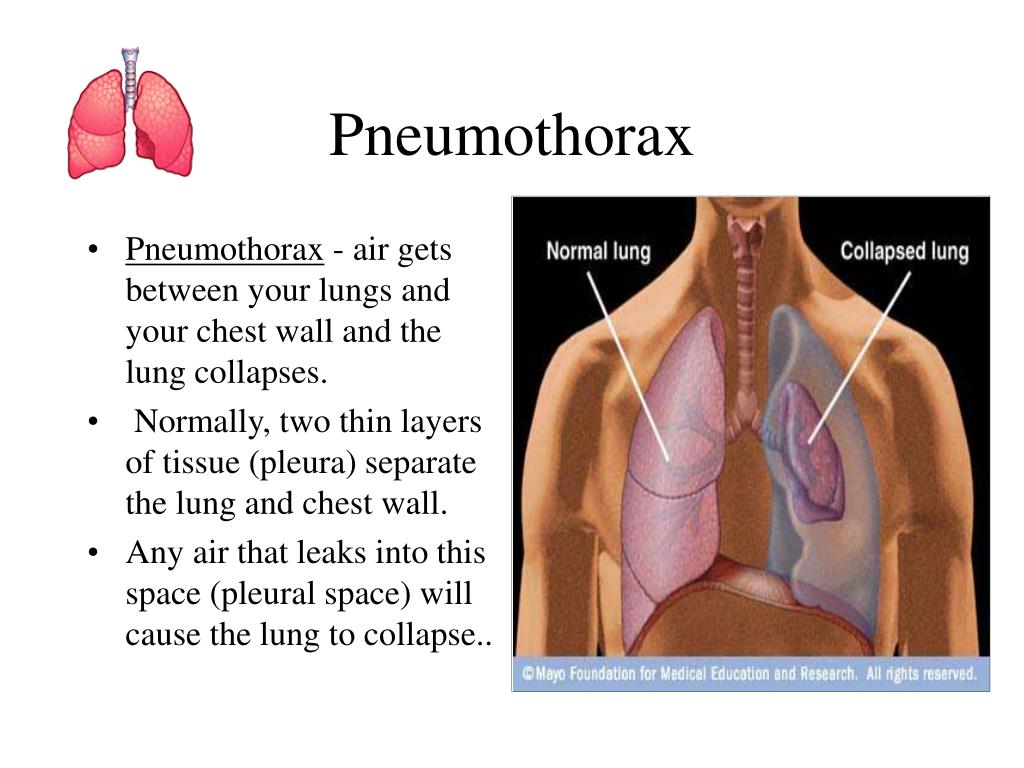
Common Symptoms
- Sudden, sharp chest pain that worsens with deep breathing or coughing
- Shortness of breath or difficulty breathing
- Rapid heart rate
- Cyanosis (bluish discoloration of the skin due to lack of oxygen)
- Fatigue and weakness
In some cases, especially with a small pneumothorax, symptoms may be mild or even absent. However, any suspicion of a collapsed lung warrants immediate medical evaluation.
When to Seek Emergency Care
Seek immediate medical attention if you experience sudden chest pain accompanied by difficulty breathing, especially after a traumatic injury. These symptoms could indicate a tension pneumothorax, which is a medical emergency requiring rapid intervention.
Diagnosing a Collapsed Lung
Accurate diagnosis of pneumothorax is essential for appropriate treatment. Healthcare providers employ various diagnostic tools and techniques to confirm the presence and extent of lung collapse.
Physical Examination
The initial assessment typically involves a thorough physical examination. The healthcare provider will listen to your breath sounds with a stethoscope. Decreased or absent breath sounds on the affected side can indicate a pneumothorax.
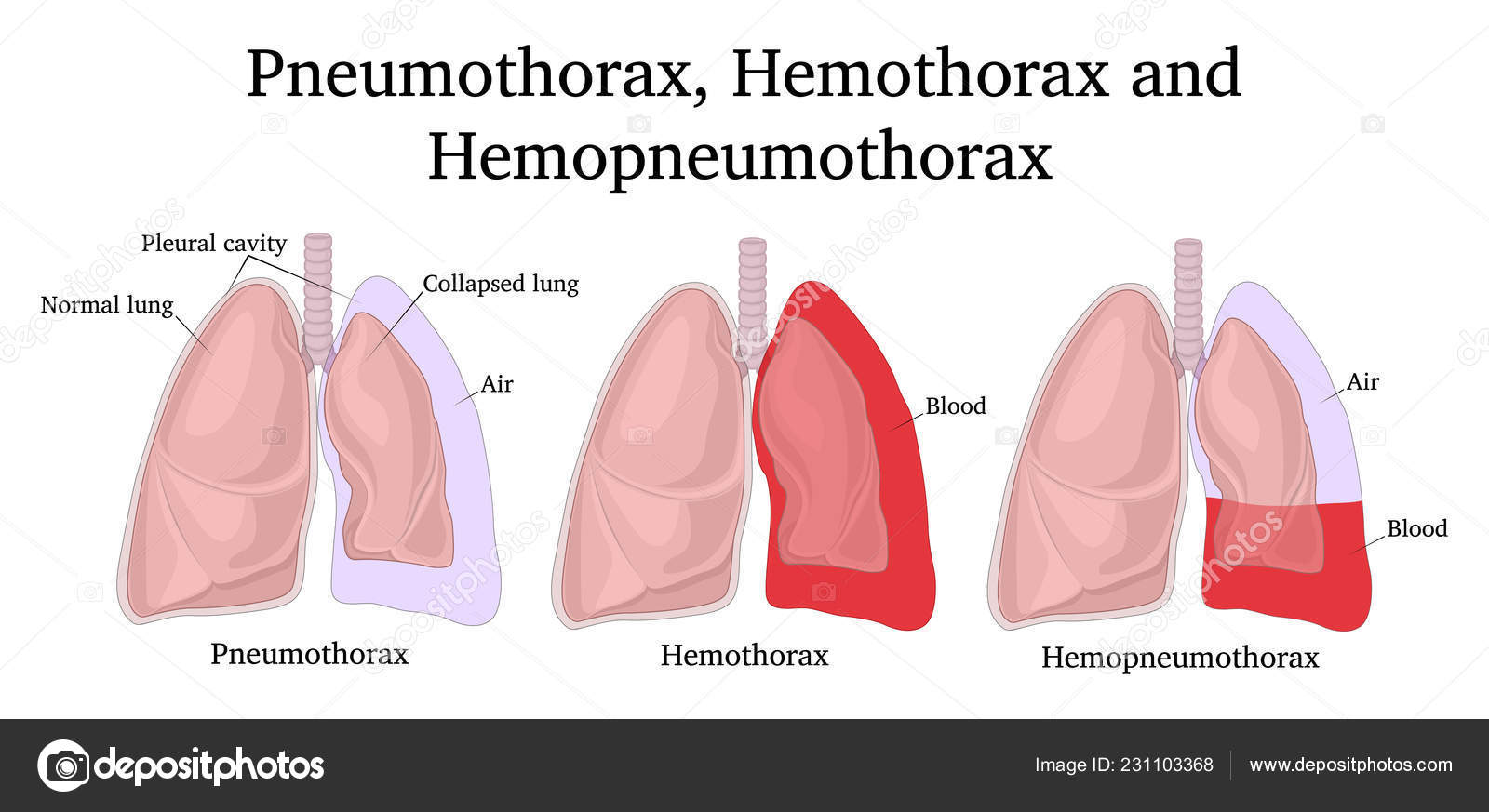
Imaging Studies
- Chest X-ray: The primary diagnostic tool for pneumothorax
- CT scan: Provides more detailed images, especially for small pneumothoraces
- Ultrasound: Increasingly used for rapid bedside diagnosis in emergency settings
Additional Tests
- Arterial blood gas analysis: Assesses oxygenation and carbon dioxide levels
- Pulse oximetry: Monitors blood oxygen saturation
These diagnostic methods help healthcare providers determine the size and location of the pneumothorax, guiding treatment decisions and monitoring recovery.
Treatment Approaches for Pneumothorax
The treatment of a collapsed lung depends on several factors, including the size of the pneumothorax, its cause, and the patient’s overall health status. The primary goal is to remove the excess air from the pleural space and prevent recurrence.
Conservative Management
For small, asymptomatic pneumothoraces, watchful waiting with supplemental oxygen therapy may be sufficient. The body can often reabsorb small amounts of air over time. This approach typically involves:

- Close monitoring with serial chest X-rays
- Pain management
- Oxygen therapy to promote faster reabsorption of air
Needle Aspiration
For larger pneumothoraces or those causing symptoms, needle aspiration may be performed. This procedure involves:
- Inserting a needle into the chest cavity
- Manually removing air from the pleural space
- Monitoring for lung re-expansion
Chest Tube Insertion
In cases of significant lung collapse or recurrent pneumothorax, a chest tube may be inserted. This involves:
- Placing a flexible tube between the ribs into the pleural space
- Connecting the tube to a one-way valve or underwater seal system
- Continuous drainage of air and any accumulated fluid
- Monitoring for lung re-expansion and removal of the tube when appropriate
Surgery
For recurrent pneumothoraces or those that don’t resolve with less invasive methods, surgical intervention may be necessary. Surgical options include:
- Video-assisted thoracoscopic surgery (VATS)
- Pleurodesis: A procedure to create adhesions between the lung and chest wall
- Bullectomy: Removal of blebs or bullae (air-filled sacs) on the lung surface
The choice of treatment depends on the individual case and is determined by the healthcare team in consultation with the patient.
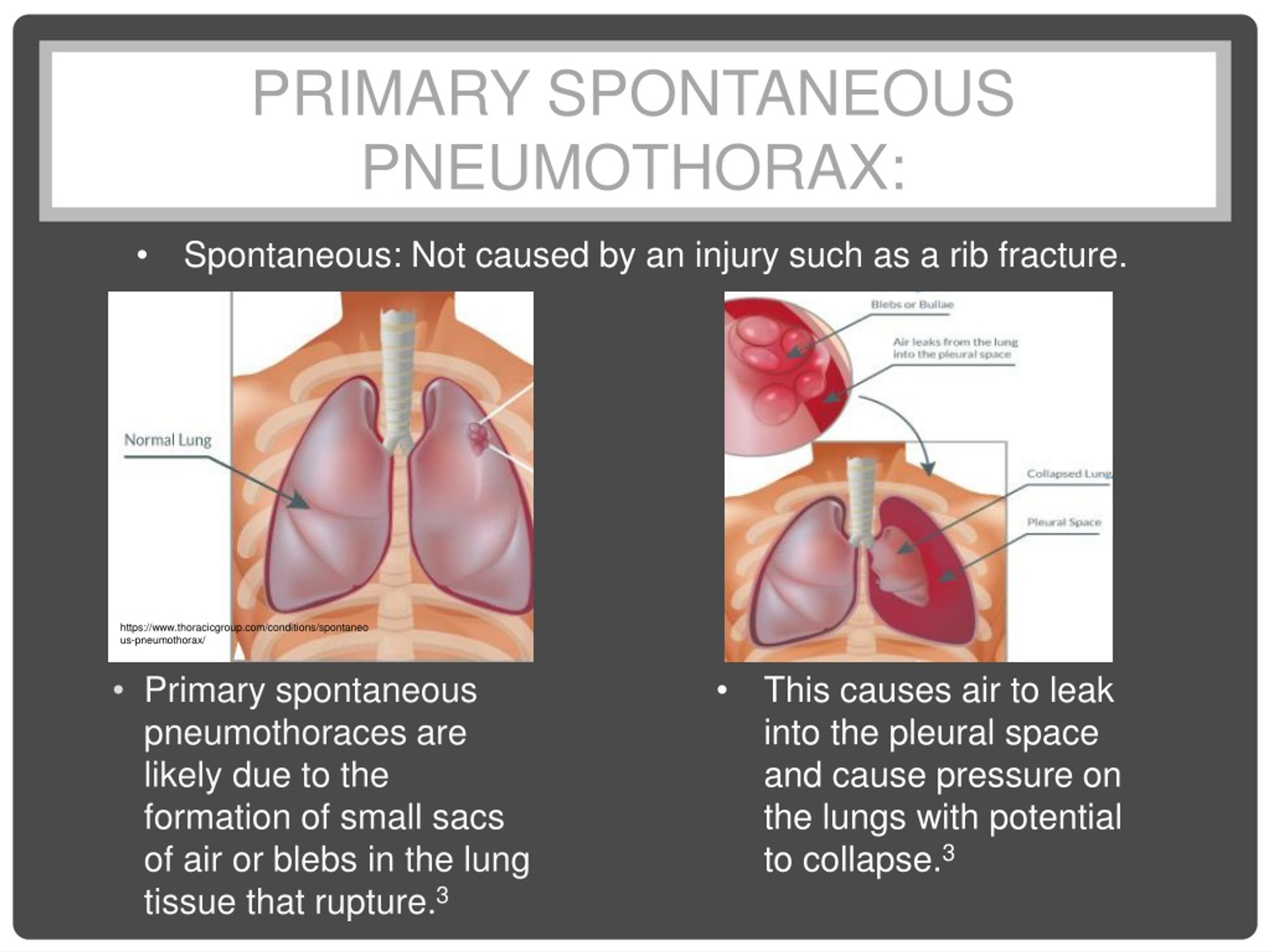
Recovery and Self-Care After Pneumothorax
Recovery from a pneumothorax requires careful adherence to medical advice and adopting certain lifestyle changes to promote healing and prevent recurrence.
Post-Treatment Care
- Follow-up chest X-rays to ensure complete lung re-expansion
- Gradual return to normal activities as advised by your healthcare provider
- Pain management with prescribed or over-the-counter medications
- Breathing exercises to improve lung function
Lifestyle Modifications
To reduce the risk of recurrence and promote overall lung health:
- Quit smoking and avoid secondhand smoke
- Avoid activities that involve sudden changes in air pressure (e.g., scuba diving)
- Maintain a healthy weight and engage in regular, gentle exercise
- Avoid exposure to air pollution and chemical fumes
It’s crucial to attend all follow-up appointments and report any new or worsening symptoms to your healthcare provider promptly.
Preventing Pneumothorax: Risk Reduction Strategies
While not all cases of pneumothorax can be prevented, certain measures can significantly reduce the risk, especially for traumatic and iatrogenic causes.
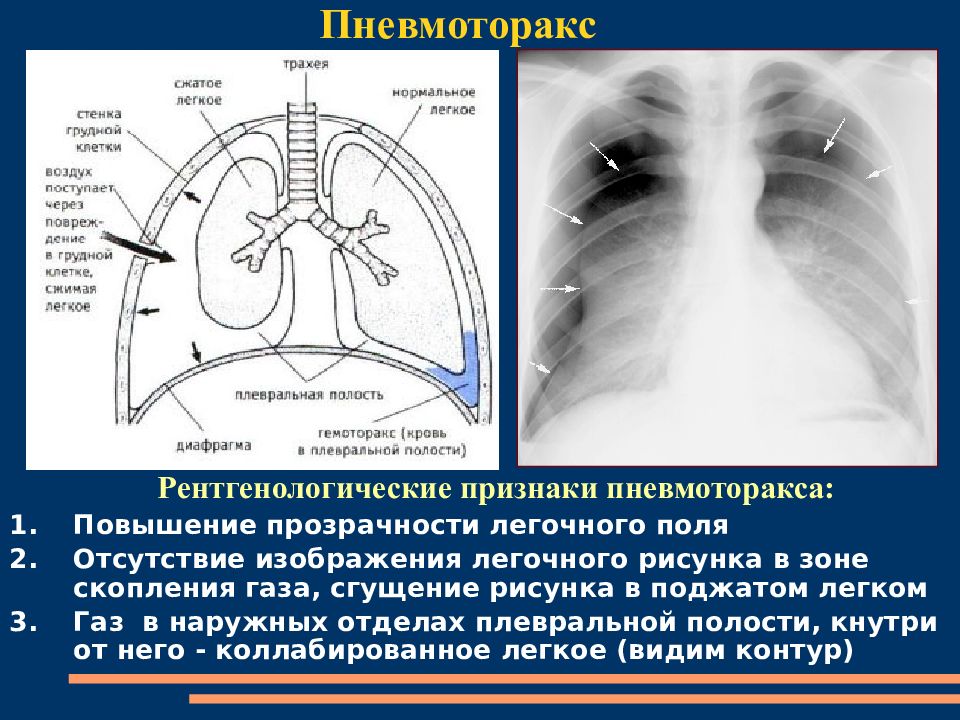
General Prevention Tips
- Wear appropriate protective gear during high-risk activities
- Practice safe driving habits and always wear a seatbelt
- Avoid smoking and exposure to secondhand smoke
- Manage underlying lung conditions effectively
Occupational Safety
For individuals working in environments with increased risk:
- Use proper respiratory protection in dusty or chemical-laden environments
- Follow safety protocols when working at heights or with machinery
- Undergo regular health check-ups, including lung function tests
Medical Procedure Precautions
To reduce the risk of iatrogenic pneumothorax:
- Healthcare providers should use ultrasound guidance for certain procedures
- Patients should inform medical staff of any history of lung problems before procedures
- Post-procedure monitoring for signs of pneumothorax in high-risk cases
By implementing these preventive measures, individuals can significantly reduce their risk of experiencing a pneumothorax, especially in cases related to trauma or medical procedures.

Long-Term Outlook and Recurrence Risk
Understanding the long-term prognosis and potential for recurrence is crucial for individuals who have experienced a pneumothorax. While many people recover fully without further issues, others may face a higher risk of recurrence.
Recurrence Rates
The likelihood of pneumothorax recurrence varies depending on several factors:
- Primary spontaneous pneumothorax: 30-50% recurrence risk within 1-2 years
- Secondary pneumothorax (due to underlying lung disease): Higher recurrence risk, up to 60-70%
- Traumatic pneumothorax: Lower recurrence risk if the initial injury heals properly
Factors Influencing Recurrence
- Continuing to smoke
- Presence of underlying lung diseases
- Height and body type (tall, thin individuals are at higher risk)
- Gender (males are at higher risk)
- Previous episodes of pneumothorax
Long-Term Management
For individuals at high risk of recurrence, long-term management strategies may include:
- Regular follow-up appointments with a pulmonologist
- Periodic chest imaging to monitor for early signs of recurrence
- Lifestyle modifications to reduce risk factors
- In some cases, preventive surgical interventions may be considered
It’s important for individuals who have experienced a pneumothorax to maintain open communication with their healthcare providers and adhere to recommended follow-up care to minimize the risk of recurrence and ensure optimal lung health.
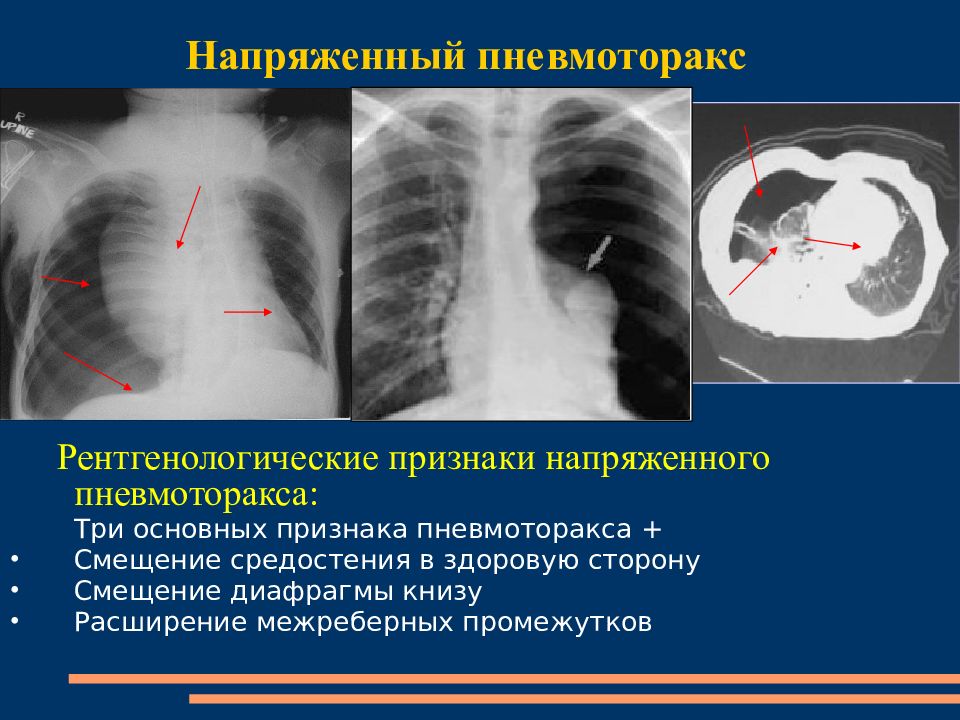
Psychological Impact and Quality of Life After Pneumothorax
The experience of a collapsed lung can have significant psychological effects on individuals, impacting their quality of life and mental well-being. Understanding and addressing these aspects is crucial for comprehensive care and recovery.
Common Psychological Reactions
- Anxiety about recurrence
- Fear of engaging in physical activities
- Depression or mood changes
- Post-traumatic stress, especially in cases of traumatic pneumothorax
Impact on Daily Life
A pneumothorax experience can affect various aspects of an individual’s life:
- Work performance and attendance
- Participation in sports and physical activities
- Social interactions and relationships
- Overall sense of health and well-being
Coping Strategies and Support
To address the psychological impact and improve quality of life:
- Seek counseling or join support groups for individuals with similar experiences
- Practice stress-reduction techniques such as mindfulness or yoga
- Gradually reintroduce physical activities under medical guidance to rebuild confidence
- Educate family and friends about the condition to foster understanding and support
Healthcare providers should be aware of the potential psychological implications of pneumothorax and offer appropriate resources and referrals as part of the comprehensive treatment plan. By addressing both the physical and psychological aspects of recovery, individuals can achieve a better overall outcome and improved quality of life following a pneumothorax experience.
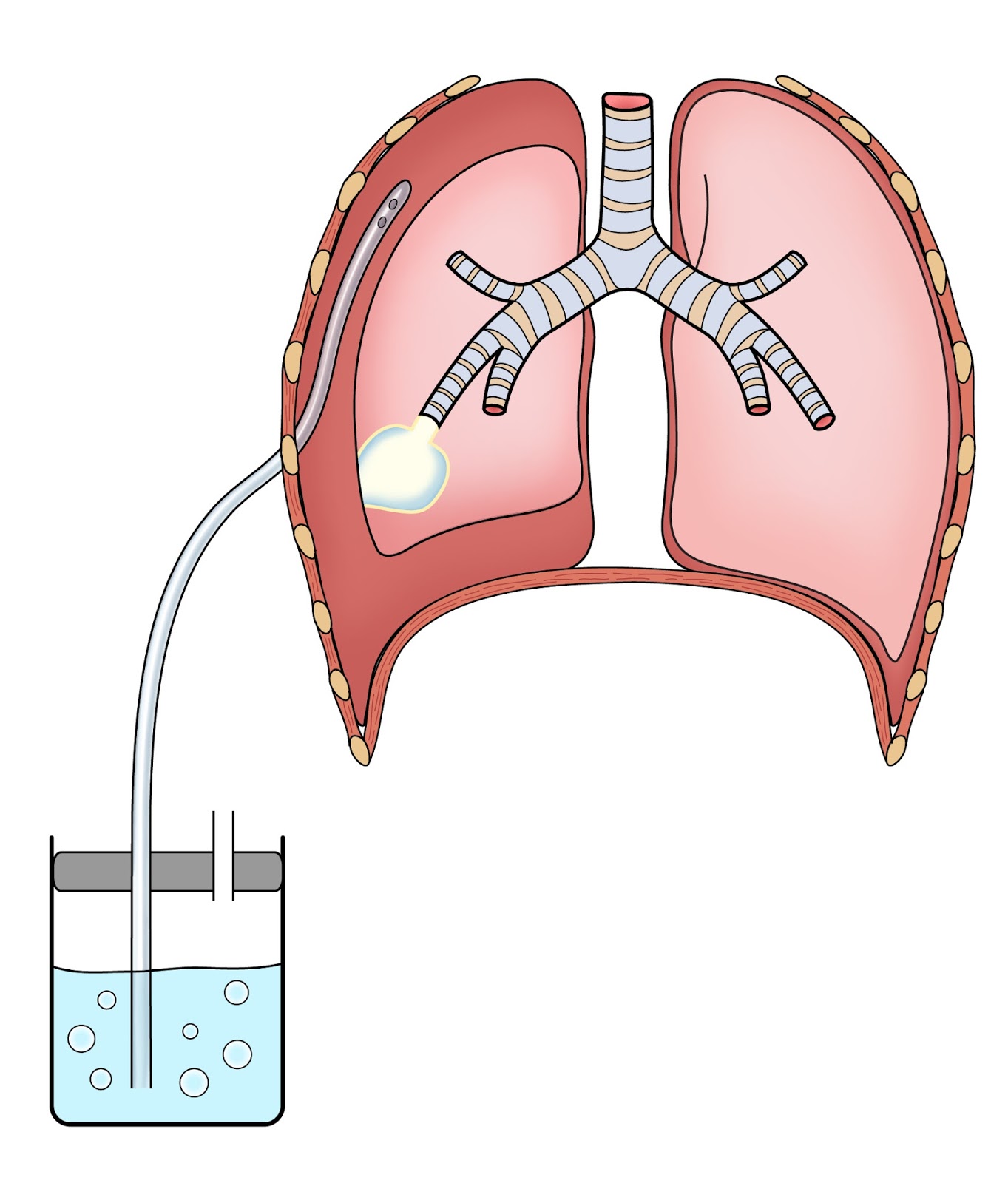
Collapsed Lung: Injury-Related – Tufts Medical Center Community Care
What is a collapsed lung?
A collapsed lung happens when air enters the space between your rib cage and one of your lungs. The air makes it hard for your lung to expand and causes part or all of the lung to collapse. When this happens, your body gets less oxygen. A collapsed lung can be life-threatening. If the air completely collapses your lung, it puts pressure on your heart. Then your heart cannot pump normally. A collapsed lung is also called a pneumothorax.
What is the cause?
A collapsed lung is usually caused by an injury such as:
- Car accidents
- A stab or bullet wound
- Fractured ribs Electric shock
- Drowning
What are the symptoms?
Symptoms may include:
- Chest pain
- Trouble breathing and feeling short of breath
- Feeling lightheaded if you are not getting enough oxygen
How is it diagnosed?
Your healthcare provider will ask about your symptoms and medical history and examine you. Tests may include:
Tests may include:
- Chest X-rays
- Blood tests
How is it treated?
Treatment depends on the cause and size of the collapsed lung and how long you have had it. Treatment is usually done in the hospital, often in the emergency room. You will be given oxygen if you need it.
If only a small part of your lung collapsed and you have mild or no symptoms, you may not need treatment. The extra air in the chest is usually absorbed by your body over the next few days. You may be allowed to go home the same day. You will need follow-up chest X-rays to make sure your lung is working properly and the air is being absorbed.
If a large part of your lung has collapsed, the air needs to be removed from your chest right away so your lung can fill with air again. This may be done with:
- Thoracentesis, which uses a needle inserted through a space between your ribs to draw out air. You will feel immediate relief, but it may take several days for your lung to completely fill with air again.

- A chest tube, which is a flexible tube inserted between your ribs into your chest. Suction is often used to help drain fluid and air from the space between your rib cage and lungs.
You may need to stay at the hospital for several days if air was removed from your chest with a needle or with a chest tube. You will be checked to make sure your lung is filling with air and is not likely to collapse again.
How can I take care of myself?
Follow the full course of treatment prescribed by your healthcare provider. In addition:
- Prop pillows behind your head and chest when you lie down to help you breathe and relieve chest pain.
- Take nonprescription medicine, such as acetaminophen, ibuprofen, or naproxen to treat pain and fever. Read the label and take as directed. Unless recommended by your healthcare provider, you should not take these medicines for more than 10 days.
- Nonsteroidal anti-inflammatory medicines (NSAIDs), such as ibuprofen, naproxen, and aspirin, may cause stomach bleeding and other problems.
 These risks increase with age.
These risks increase with age. - Acetaminophen may cause liver damage or other problems. Unless recommended by your provider, don’t take more than 3000 milligrams (mg) in 24 hours. To make sure you don’t take too much, check other medicines you take to see if they also contain acetaminophen. Ask your provider if you need to avoid drinking alcohol while taking this medicine.
- Nonsteroidal anti-inflammatory medicines (NSAIDs), such as ibuprofen, naproxen, and aspirin, may cause stomach bleeding and other problems.
- Take cough medicine if recommended by your healthcare provider.
- Don’t smoke, and stay away from others who are smoking (secondhand smoke).
- Avoid breathing dust and chemical fumes.
- Get plenty of rest.
Ask your provider:
- How long it will take to recover
- If there are activities you should avoid and when you can return to your normal activities
- How to take care of yourself at home
- What symptoms or problems you should watch for and what to do if you have them
Make sure you know when you should come back for a checkup. Keep all appointments for provider visits or tests.
Keep all appointments for provider visits or tests.
How can I prevent an injury-related collapsed lung?
Collapsed lungs are often caused by car accidents. To help avoid chest injuries, wear seat belts and use airbags. Make sure that your child is buckled into an approved car safety seat. All children under 13 years of age should ride in the rear seat of vehicles. Never place a child in the front seat of a vehicle if it has an airbag.
Adult Advisor 2015.1 published by RelayHealth.
Last modified: 2014-10-21
Last reviewed: 2014-07-31
This content is reviewed periodically and is subject to change as new health information becomes available. The information is intended to inform and educate and is not a replacement for medical evaluation, advice, diagnosis or treatment by a healthcare professional.
Copyright ©1986-2015 McKesson Corporation and/or one of its subsidiaries. All rights reserved.
South Tees Hospitals NHS Foundation Trust
Emergency Department and Minor Injury Unit
You have been given this information because you have been diagnosed with a pneumothorax.

A pneumothorax (collapsed lung) occurs when air is trapped between a lung and the chest wall. This can occur from an injury, such as broken ribs or a wound to the chest, but commonly occurs spontaneously. Spontaneous pneumothorax is thought to be due to a tiny tear of an outer part of the lung.
Treatment of a pneumothorax
A small pneumothorax may require no treatment.
A larger pneumothorax, that is causing shortness of breath, may be treated with a tube inserted into the chest known as a chest drain.
Recovering from a pneumothorax
Flying
If you currently have a pneumothorax you should not fly at all. This is because of the risk of the trapped air expanding and causing a tension pneumothorax (a life-threatening emergency), which can happen when the air pressure around you changes.
If you have had a recent pneumothorax you should have a chest x-ray performed prior to flying to ensure that it has resolved.
It is recommended that you wait at least 1 week after this chest x-ray before flying, or 2 weeks if your pneumothorax was caused by an injury.
The risk of recurrence does not fall significantly for at least 1 year, and is higher in those with coexisting lung disease. You may wish to consider alternative forms of transport during this time.
Scuba diving
This also increases the risk of developing a tension pneumothorax.
You should not scuba dive if you have ever had a spontaneous pneumothorax. If your occupation relies on diving, you may be suitable for an operation to prevent recurrence and allow you to dive again.
You may be able to dive if you have had a traumatic pneumothorax, but this depends on further investigation. Please discuss this with your GP.
Follow-up after a pneumothorax
You will be given a clinic appointment to ensure your pneumothorax has resolved. This will involve a chest x-ray.
You should seek urgent medical attention if any of the following occur:
- Increased shortness of breath
- Severe sharp, stabbing chest pain (pleuritic pain)
Treating pain
If needed, painkiller options include the following:
Paracetamol is usually recommended for painful sprains or strains.

Non-steroidal anti-inflammatory drugs (NSAIDs) relieve pain and may also limit inflammation and swelling. You can buy some types (for example, ibuprofen) at pharmacies, without a prescription either topically as a cream, or as tablets. You should check the medication advice leaflet to ensure you are safe to take these as some patients with asthma or stomach ulcers may not be able to.
If this does not help, you may need an additional stronger painkiller – such as codeine – you should discuss this with your pharmacist or GP.
For further advice and information about your condition, please choose from the following:
- ‘NHS Patient Choices’ website: www.nhs.uk
- ‘Making Lives Better’ patient website: www.patient.info
- Telephone NHS 111
- Contact your General Practitioner
Contact details
- The James Cook University Hospital, Marton Road, Middlesbrough, TS4 3BW
Telephone: 01642 850850 - The Friarage, Northallerton, North Yorkshire, DL6 1JG
Telephone: 01609 779911 - Redcar Primary Care Hospital, West Dyke Road, Redcar, TS10 4NW
Telephone: 01642 511000
Patient experience
South Tees Hospitals NHS Foundation Trust would like your feedback. If you wish to share your experience about your care and treatment or on behalf of a patient, please contact The Patient Experience Department who will advise you on how best to do this.
If you wish to share your experience about your care and treatment or on behalf of a patient, please contact The Patient Experience Department who will advise you on how best to do this.
This service is based at The James Cook University Hospital but also covers the Friarage Hospital in Northallerton, our community hospitals and community health services.
To ensure we meet your communication needs please inform the Patient Experience Department of any special requirements, for example; braille or large print.
T: 01642 835964
E: [email protected]
The James Cook University Hospital, Marton Road, Middlesbrough, TS4 3BW.
Telephone: 01642 850850
ST1614
Spontaneous pneumothorax: discussion of lung collapse
Spontaneous pneumothorax is the collapse of one or both lungs caused by air entering the pleural cavity.
The pleura is a thin membrane made up of two “sheets” that line each lung and the inside of the chest.
The pleural cavity is the space between the two layers of the pleura, and it is here that the abnormal intake of air occurs, causing pneumothorax.
Spontaneous pneumothorax in children is quite rare.
However, if this happens once, it is very likely that there will be a relapse.
Spontaneous pneumothorax may have no apparent cause.
Sometimes this can happen as a result of a lung disease in a child.
The most common is an asthmatic condition that is poorly controlled.
Pneumothorax is very often caused by trauma to the chest.
Primary spontaneous pneumothorax is not caused by lung disease and its causes are largely unknown.
In contrast, in secondary spontaneous pneumothorax, lung collapse is caused by lung disease.
The most common symptom is sudden chest pain that gets worse with breathing.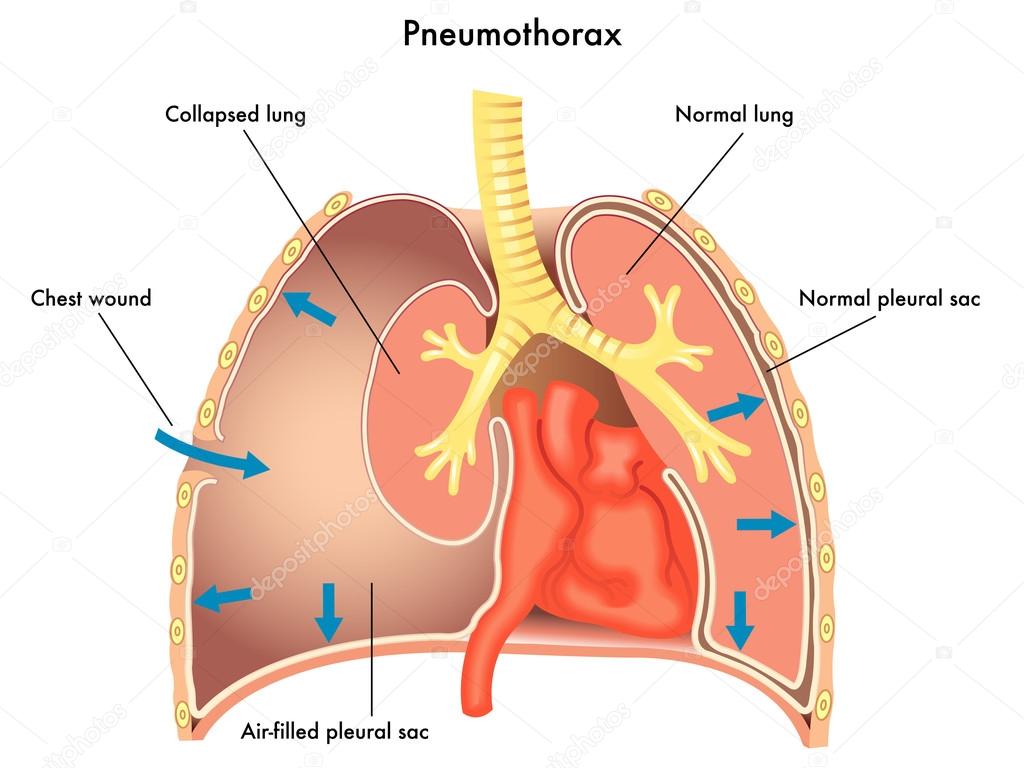
Other symptoms are cough, shoulder pain or sharp pain between the shoulder blades.
In most cases, these symptoms do not last long and very rarely get worse.
Diagnosis is based on a thorough history of the child and an equally thorough physical examination.
Spontaneous pneumothorax is often diagnosed on chest x-ray. emergency care.
If the doctor needs more detailed images of the lungs, in some cases he or she may also request a computed tomography (CT) scan.
A CT scan will identify and measure “blisters” (or bullae), which are small air-filled bubbles that can form on the surface of the lung.
Spontaneous pneumothorax can often be caused by rupture of these bullae, which release air into the pleural space.
Treatment is not always necessary immediately after spontaneous pneumothorax.
Small patients are hospitalized for close observation.
Oxygen is sometimes enough to relieve difficulty breathing (shortness of breath) and medicines to control the pain.
If, on the other hand, there is a risk that the lung will be over-compressed by air escaping into the pleural cavity, or that spontaneous pneumothorax will make breathing difficult, the air will need to be removed.
This procedure can be performed by sucking air with a needle or by inserting a tube into the chest to force air out of the pleural cavity.
If a recurrence occurs, surgery may be required to “glue” the pleura and prevent the lung from collapsing again.
Another procedure that can be used is videothoracoscopy, which consists of a relatively non-invasive laparoscopy performed under general anesthesia.
Videothoracoscopy is performed using a thin tubular instrument with a camera at the end.
This tube is inserted into the chest through a small incision and allows visualization and removal of air bubbles.
Open thoracotomy, i.e. a surgical incision in the chest, is less commonly used today to remove blisters.
The prognosis is usually good, and with proper treatment, pneumothorax tends to resolve quickly.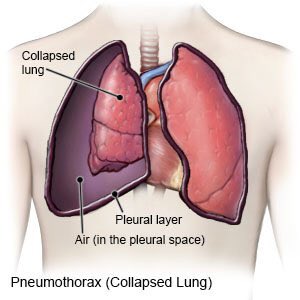
When a child is discharged, the family is advised to take him or her to the emergency room immediately if chest pain or difficulty breathing reappears.
These symptoms may indicate recurrent pneumothorax.
Read also:
Emergency Live even more … Live: Download the new free application of your newspaper for iOS and Android
Emphysema Emphysema: Symptoms, Diagnostics and Treatment
Respiratory Transport after a traffic accident: Overview of
6666 Tracheal intubation: when, how and why to create an artificial airway for a patient
What is transient neonatal tachypnea or neonatal wet lung syndrome?
Traumatic pneumothorax: symptoms, diagnosis and treatment
Diagnosis of tension pneumothorax in the field: suction or blowing?
Pneumothorax and pneumomediastinum: saving the patient with barotrauma of the lung
Difference between AMBU balloon and emergency breathing balloon: advantages and disadvantages of the two main devices
Cervical collar in trauma patients in emergency medicine: when to use it, why it is important
KED Trauma Extraction Device: what it is and how to use it
ABC, ABCD and ABCDE rules in emergency medicine: what the rescuer must do
Multiple rib fractures, chain chest (rib cage) and pneumothorax: an overview
Primary, secondary and hypertensive spontaneous pneumothorax: causes, symptoms, treatment
Pneumothorax and hemothorax: trauma of the chest cavity and its consequences
source:
Baby Jesus
Treatment of pulmonary hemothorax in Israel
The pulmonology department of the Ichilov clinic offers a wide range of services, including the most modern methods known today, used to diagnose lung diseases and treat various diseases of the chest, including hemothorax lungs.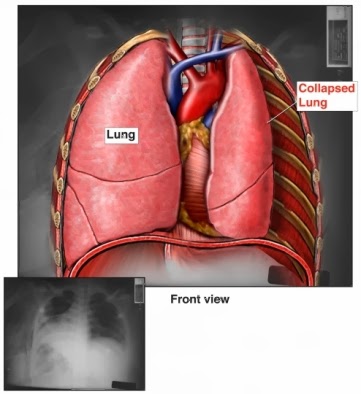
100%
online consultations with an Israeli expert are organized within 2-3 days
>30%
patients received innovative treatment not available in domestic clinics
2384
patients used complex medicine services
Table of contents
Treatment methods
Diagnostics
Prices 9 0007
The doctors of the clinic are specialists in the field of diseases of the respiratory system, as well as in the treatment of internal diseases, pediatric and intensive lung therapy, oncology and sports medicine. In addition to highly qualified medical and nursing staff, the team includes laboratory and medical equipment technologists, physiotherapists, physiologists and psychologists.
Ichilov Pulmonology Department provides its services in close cooperation with other departments of the center, such as the department of radiology, thoracic surgery, oncology, microbiology and nuclear medicine. Reviews and video reviews about the treatment in Ichilov can be viewed and read in the appropriate section of the site.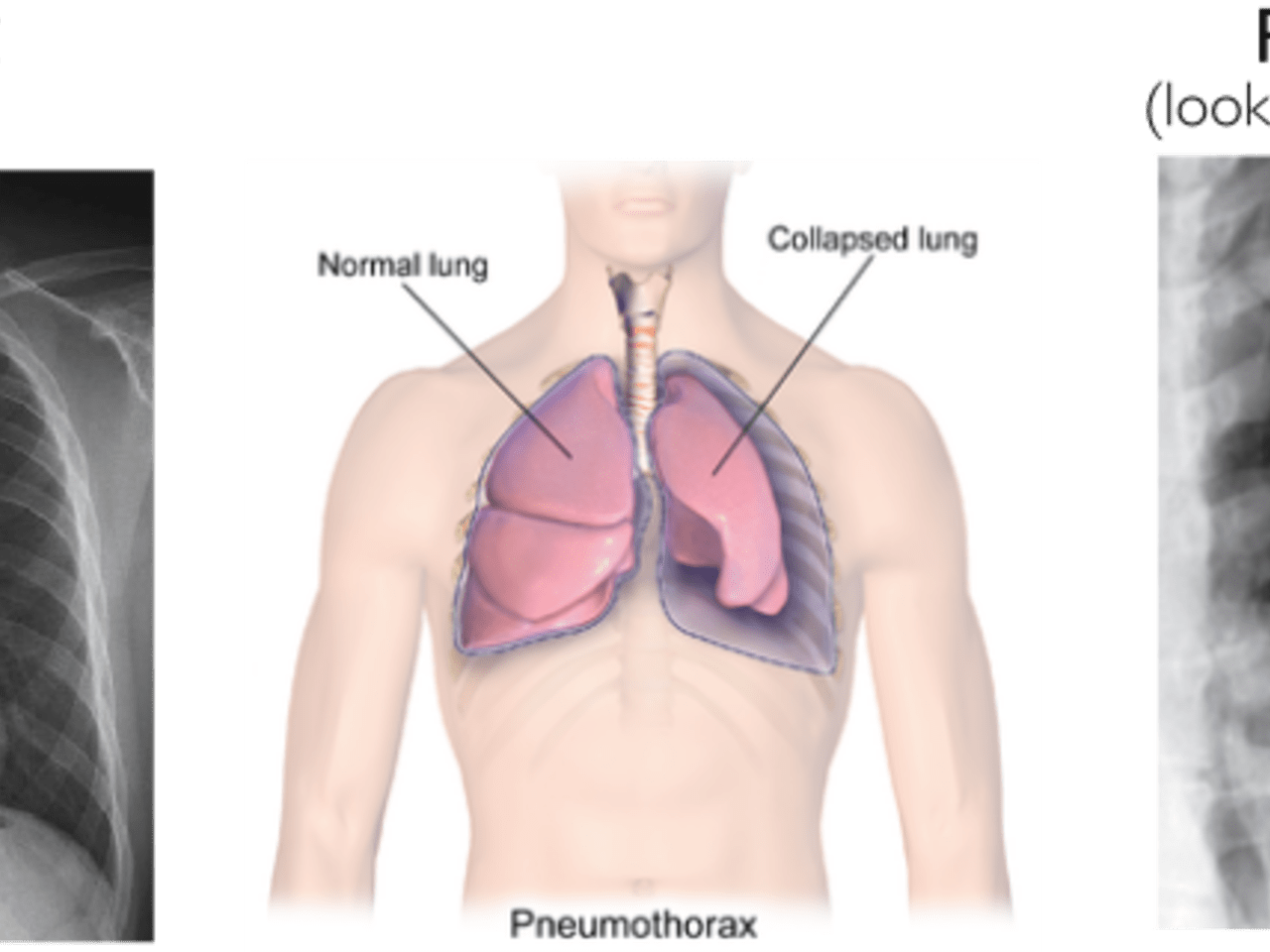
About the disease
Hemothorax is a collection of blood between the chest wall and the lungs. This area where blood can accumulate is called the pleural cavity. The accumulation of blood volume in this space can eventually lead to lung collapse as the blood is pushed out of the lung.
The accumulation of blood in the chest can have many causes. It is most common after major chest injuries or surgeries that involve opening the chest, especially after heart or lung surgery. Some conditions in which blood does not clot properly can also cause hemothorax.
Hemothorax can be caused by many of the same causes that cause pneumothorax. Pneumothorax occurs when there is too much air between the chest wall and the lungs. This puts too much pressure on the lung and causes the lung or part of it to collapse.
Methods of treatment of the disease
The goal of the treatment of pulmonary hemothorax is to stabilize the person’s condition, stop bleeding and remove blood and air from the pleural cavity.
Drainage
A drainage tube is inserted through the chest wall between the ribs to drain blood and air. It is left in place and attached to a suction for several days to expand the lung again.
Thoracotomy
If bleeding continues even during drainage, the patient may need surgery to correct the cause of the bleeding. Video-assisted thoracoscopic surgery is by far the most effective treatment for clotted hemothorax compared to other methods. The type of thoracotomy needed depends on which part of the chest or organs the surgeon needs to operate on. After the surgeon completes the operation, a tube will remain in the chest to drain any remaining blood or fluid.
Conservative therapy
Conservative therapy for pulmonary hemothorax includes the use of blood transfusion and hemostatic therapy, as well as antibacterial agents.
How the disease is diagnosed
After identifying the signs of the disease, the doctor will measure and monitor the person’s vital signs, including oxygen saturation, pulse, respiratory rate and blood pressure. Symptoms will be treated as needed. The patient may need respiratory support. This may include oxygen, non-invasive airway pressure support such as BIPAP, or endotracheal intubation (placement of a breathing tube through the mouth or nose into the airways) and placement on a ventilator (life-support breathing apparatus)
Symptoms will be treated as needed. The patient may need respiratory support. This may include oxygen, non-invasive airway pressure support such as BIPAP, or endotracheal intubation (placement of a breathing tube through the mouth or nose into the airways) and placement on a ventilator (life-support breathing apparatus)
The following types of diagnostic procedures may also be performed.
- Blood tests
- X-ray: A chest X-ray will quickly show if there is fluid in the chest cavity. On an x-ray, the lungs will turn black, and the pleural fluid and any blood in the chest cavity will turn white.
- CT: This can give doctors a complete picture of the lungs and pleural cavity, which can be especially important in the event of an injury. A complete chest CT scan can often reveal the cause of a hemothorax and determine the best treatment for a person.
- Ultrasound: In an emergency, ultrasound images allow you to quickly and accurately examine the pleural cavity for possible damage and hemothorax.

Doctors may also take a sample of pleural fluid to help make an accurate diagnosis. If cancer, tuberculosis, or another underlying disease is suspected to be the cause of the hemothorax, additional blood or imaging tests are recommended to ensure proper diagnosis and appropriate treatment.
Hemothorax is a serious condition that can be life-threatening if left untreated. With timely medical care and uncomplicated hemothorax, the prognosis is positive.
How much does it cost to treat a hemothorax
The cost of medical care in Israel is based on standards that regulate the price of medical services for foreign citizens and prohibit hospitals from increasing the cost of treating patients from abroad. By contacting the Israeli clinic Ichilov, the patient can save 30-50% of financial resources compared to treatment in a medical facility of the same level in Germany or the USA.
The benefits of treatment in Ichilov
- The doctors of the Ichilov pulmonology department work in collaboration with specialists from related specialties to provide the best care for patients.



 These risks increase with age.
These risks increase with age.

